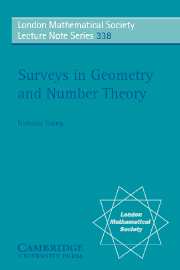Book contents
- Frontmatter
- Contents
- Preface
- Affine embeddings of homogeneous spaces
- Formal groups over local fields: a constructive approach
- Classification problems and mirror duality
- Birational models of del Pezzo fibrations
- Best Diophantine approximations
- Projectively dual varieties of homogeneous spaces
- Equivariant embeddings of homogeneous spaces
- Geometric quantization and algebraic Lagrangian geometry
Projectively dual varieties of homogeneous spaces
Published online by Cambridge University Press: 07 May 2010
- Frontmatter
- Contents
- Preface
- Affine embeddings of homogeneous spaces
- Formal groups over local fields: a constructive approach
- Classification problems and mirror duality
- Birational models of del Pezzo fibrations
- Best Diophantine approximations
- Projectively dual varieties of homogeneous spaces
- Equivariant embeddings of homogeneous spaces
- Geometric quantization and algebraic Lagrangian geometry
Summary
Introduction
Various manifestations of projective duality have inspired research in algebraic and differential geometry, classical mechanics, invariant theory, combinatorics, etc. On the other hand, projective duality is simply a systematic way of recovering a projective variety from the set of its tangent hyperplanes. In this survey we have tried to collect together different aspects of projective duality and points of view on it. To save space we omit almost all proofs, but even this cannot save these notes from being incomplete. We hope that the interested reader will take a closer look at the many beautiful papers and books cited here.
An interesting feature of projective duality is given by the observation that the most important examples carry a natural action of a Lie group. This is especially true for projective varieties that have extremal properties from the point of view of projective geometry. We have tried to stress this phenomenon in this survey and to discuss many variants of it. However, one aspect is completely omitted – we do not discuss the dual varieties of toric varieties and the corresponding theory of A-discriminants. This theory is presented in the fundamental book and we feel no need to reproduce it.
I would like to thank F. Zak for very inspiring discussions on projective geometry and S. Keel for many critical remarks that helped to improve the exposition. I am grateful to P. Aluffi, R. Muñoz, V. Popov, D. Saltman and A. J. Sommese for many helpful comments and encouragement. These lecture notes were written during my stay at the University of Glasgow and I would like to thank my hosts for their warm hospitality.
Information
- Type
- Chapter
- Information
- Surveys in Geometry and Number TheoryReports on Contemporary Russian Mathematics, pp. 183 - 225Publisher: Cambridge University PressPrint publication year: 2007
